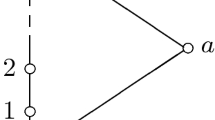Abstract
This is the first of a planned series of investigations on the theory of ordered spaces based upon four axioms. Two of these, the order (I.1.1) and the local structure (II.5.1) axioms provide the structure of the theory, and the other two [the identification (I.1.11) and cone (I.2.7) axioms] eliminate pathologies or excessive generality. In the present paper the axioms are supplemented by the nontriviality conditions (I.1.9) and a regularity property (II.4.2).
The starting point is a nonempty setM and a family of distinguished subsets, calledlight rays, which are totally ordered. The order axiom provides the properties of this order. Positive and negative cones at a point are defined in terms of increasing and decreasing subsets and are used to extend the total order on the light rays to a partial order over all ofM. The first significant result is thepolygon lemma (I.2.3) which provides an essential constructive tool. A non-topological definition is found for the interiors of the cones; it leads to a “more homogeneous” partial order relation onM.
In Sect. II, subsets calledD-sets (Def. II.2.2), possessing certain desirable properties, are studied. The key concept ofperpendicularity of light rays is isolated (Def. II. 3.1) and used to derive the basic “separation properties,” provided that the interiors of cones are nonempty. It is shown that, in aD-set, “good” properties of one cone can be transported along light rays, so that the structure of aD-set is homogeneous. In particular, if one cone has nomempty interior, so have all others. However, the existence of even one cone with nomepty interior does not follow from the axioms, but has to be imposed as an additionalregularity condition. The local structure axiom now states that every point lies in a regularD-set. It is proved that the family of regularD-sets is closed under finite intersections. Theorder topology is defined as the topology which has this family as a base. This topology is Hausdorff, and coincides with the usual topology for Minkowski spaces.
Similar content being viewed by others
References
Alexandrov, A.D.: Filosofskoe soderzhanie i znachenie teorii otnositel'nost. Voprosy Filosofii No.1, 67–84 (1959)
Atiyah, M.: On the work of Simon Donaldson. In: Proc. International Conf. of Mathematicians, 1986, Vol. 1, pp. 3–6, Am. Math. Soc., 1987
Donaldson, S.: The geometry of 4-manifolds. In: Proc. International Conf. of Mathematicians 1986, Vol. 1, pp. 43–54, Am. Math. Soc., 1987
Donaldson, S.: An application of gauge theory to four-dimensional topology. J. Differ. Geom.18, 279–315 (1983)
Freedman, M.H.: There is no room to spare in four-dimensional space. Notices Am. Math. Soc.31, 3–6 (1984)
Freedman, M.H.: The topology of four-dimensional manifolds. J. Differ. Geom.17, 357–453 (1982)
Gompf, R.: Three exotic ℝ4's and other anomalies. J. Differ. Geom.18, 317–328 (1983)
Gompf, R.: An infinite set of exotic ℝ4's. J. Differ. Geom.21, 283–300 (1985)
Kelley, J.L.: General topology, p. 57, ex I. Princeton, NJ, Toronto, New York, London: Van Nostrand 1955
Milnor, J.: The work of M. H. Freedman. In: Proc. International Conf. of Mathematicians 1986, Vol. 1, pp. 13–15, Am. Math. Soc., 1987
Willard, S.: General topology, p. 5. Reading, MA: Addison-Wesley 1970
Zeeman, E.C.: The topology of Minkowski space. Topology6, 161–170 (1967)
References
Schröter, J.: An axiomatic basis of space-time theory, part I: Construction of a causal space with coordinates. Rep. Math. Phys.26, 303–333 (1988)
Weyl, H.: Space-time-matter (translated from the German by Henry L. Brose), 4th edition, 1922, Reprinted by Dover Publications, USA
Synge, J.L.: Relativity, the special theory, 2nd edition. North-Holland: Amsterdam 1965
Synge, J.L.: Relativity, the general theory. North-Holland: Amsterdam 1971
Ehlers, J., Pirani, F.A.E., Schild, A.: The geometry of free fall and light propagation. In: General relativity: papers in honour of J. L. Synge, O'Raifeartaigh, L. (ed.) pp. 63–84. Clarendon Press: Oxford 1972
Woodhouse, N.M.J.: The differentiable and causal structures of space-time. J. Math. Phys.14, 495–501 (1973)
Author information
Authors and Affiliations
Additional information
Communicated by H. Araki
Rights and permissions
About this article
Cite this article
Borchers, H.J., Sen, R.N. Theory of ordered spaces. Commun.Math. Phys. 132, 593–611 (1990). https://doi.org/10.1007/BF02156539
Received:
Issue Date:
DOI: https://doi.org/10.1007/BF02156539




